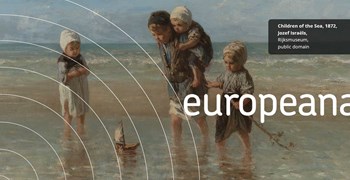Seeing is believing: the trick of the trompe l’oeil in art
Battle of Livorno, 14 March 1653, an incident from the First Anglo-Dutch War, anonymous. Rijksmuseum, public domain.
At first, the painting above looks like many you’ve seen before. A grand, naval scene with clouds billowing above inflated sails. But hang on. What’s that in the bottom corner? A crumpled note of some kind. A little flourish from the artist telling you which ship is which.
It’s just one example of a trompe l’oeil, meaning to ‘deceive the eye’ when translated from the French. It’s an artistic trick turning two dimensions into three. Art history is full of them – from banquet tables groaning with delicacies good enough to reach out and eat, to wallpaper that beckons you down a phantom corridor. Fittingly for an optical trick, the trompe l’oeil can take all shapes and sizes.
Plafondstuk voorstellende “De Faam”, Adriaen van der Werff. Rotterdam Museum, CC BY.
Like many great inventions, the trompe l’oeil started out with a competition. Two painters, Zeuxis and Parrhasius, came head to head in ancient Greece, both eager to prove they were the superior artist. Their challenge? To paint the most deceptively life-like work of art.
Zeuxis was up first, and painted some grapes so juicily real birds flew down to steal them. Parrhasius went next. He invited Zeuxis to unveil his rival work. When Zeuxis went to draw the curtain aside, he realised he had been beaten. The curtain was merely an illusion.
Two works by keen practitioner of the trompe l’oeil, Cornelius Norbertus Gijsbrechts (1657-1683). A Cabinet of Curiosities with an Ivory Tankard, An Open Cabinet of Curiosities with a Hercules Group. Both SMK, CC0.

Bear from BL Royal 19 C VIII, f. 1. Hugues de Lannoy, Quentin Poulet. British Library, public domain.
Since then, artists, engravers and illustrators have revelled in fooling their viewers with this clever effect, playing with perspective to blur the boundary between the real and the fake. Below, we’ve picked some of the more elaborate trompe l’oeil from our collections – did any of them fool you?
Trompe l’oeil. Brevvaeg med bartskaer-instrumenter, 1668. Cornelius Norbertus Gijsbrechts. SMK, CC0.
Trompe l’oeil med ateliervaeg og vanitas-stilleben, 1668. Cornelius Norbertus Gijsbrechts. SMK, CC0.
 Stilleben, trompe l’oeil. Carl Hofverberg, Skoklosters Slott. CC BY-SA.
Stilleben, trompe l’oeil. Carl Hofverberg, Skoklosters Slott. CC BY-SA.
Målning, trompe l’oeil. Carl Hoverberg, Livrustkammaren. CC BY-SA.
Trompe l’oeil, Johan Klopper. Nationalmuseum, Sweden, CC BY-SA.
Trompe l’oeil. A Cabinet in the Artist’s Studio, Cornelius Norbertus Gijsbrechts. SMK, CC0.
Brevvägg. Trompe-l’oeil, Hindric Sebastian Sommar. Nationalmuseum, Sweden, CC BY-SA.
Trompe l’oeil. Bagsiden af et indrammet maleri, Cornelius Norbertus Gijsbrechts (1657-1683). SMK, CC0.






















